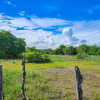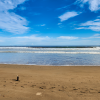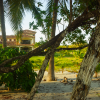The 45 Places to Go in 2012
1. Panama
Go for the canal. Stay for everything else.
Among the notable development projects is the Panama Canal itself, which is in the early stages of a multibillion-dollar expansion. The project will widen and deepen the existing canal and add two locks, doubling the canal’s cargo capacity. For those who want to see the waterway as it was originally designed, now is the time. The expansion is expected to be completed by 2014, the canal’s 100-year anniversary.
Other high-profile projects include the construction of three firsts: The Panamera, the first Waldorf Astoria hotel in Latin America (set to open in June 2012); the Trump Ocean Club, the region’s tallest building, which opened last summer; and Frank Gehry’s first Latin American design, the BioMuseo, a natural history museum scheduled to open in early 2013. Even Panama City’s famously dilapidated historic quarter, Casco Viejo, has been transformed. The neighborhood, a tangle of narrow streets, centuries-old houses and neo-colonial government buildings, was designated a Unesco World Heritage site in 1997 and is now a trendy arts district with galleries, coffeehouses, street musicians and some of the city’s most stylish restaurants and boutique hotels.
Across the isthmus, on Panama’s Caribbean coast, the Bocas del Toro archipelago has become a popular stop on the backpacker circuit, with snorkeling and zip lining by day and raucous night life after dark. FREDA MOON
2. Helsinki, Finland
Design. Design. Design. Aesthetics fuel a new cool.
Copenhagen’s culinary awakening and Stockholm’s trend-setting fashion may have ignited the world’s current infatuation with Nordic culture; now Helsinki is poised for the spotlight. The International Council of Societies of Industrial Design has designated it the World Design Capital for 2012.
Design has long been part of the city’s DNA, but in recent years the scene has been increasingly energized: the official Design District has ballooned to encompass 25 streets and nearly 200 design-minded businesses, which range from shops selling housewares and furniture to boutique hotels and clothing stores. Design has infiltrated the restaurant scene as well, notably the elegant Chez Dominique and the hot newcomer (and Michelin-starred) Olo.
On top of all that is the spectacular new $242 million Helsinki Music Center. Student ensembles from the Sibelius Academy — the sole university in Finland devoted exclusively to music — will perform in the striking glass-walled space, and both the Vienna Philharmonic and the Helsinki Philharmonic Orchestras will give concerts in 2012. INGRID K. WILLIAMS
3. Myanmar
Back on the tourist map after being off-limits for years.
With renowned cultural treasures, world-class boutique hotels and deserted beaches, Myanmar has long been high on intrepid travelers’ wish lists. For years, though, heeding calls by the pro-democracy leader Daw Aung San Suu Kyi and others, many stayed away in protest of Myanmar’s authoritarian regime.
Now, however, this is changing.
Since November 2010, when Myanmar’s rulers held nominally free elections and released Ms. Aung San Suu Kyi after 15 years of house arrest, the boycott has been lifted and Myanmar is set for an influx of visitors.
Because the country has been so isolated, the deeply Buddhist “Land of the Golden Pagoda” resonates with a strong sense of place, undiluted by mass tourism and warmed by genuine hospitality. Travelers will find atmospheric hotels and a network of well-maintained regional jets serving the main sites. (Keep in mind that visas are still required and that the economy remains largely cash-based.)
But locals are aware of the potential downside of tourism as well. Ms. Aung San Suu Kyi has called for sustainable development and “trickle down” tourism where dollars will do the most good.
With these goals in mind, nestled along the banks of meandering Lake Inle in eastern Myanmar, the ViewPoint eco-lodge combines locally sourced materials with individually tailored activities supporting the local economy (like garden-to-table lunches at an island village house).
Similarly, in Ngapali Beach — a pristine swath of coastline on the Bay of Bengal — the Amara Ocean Resort ratchets up the om factor with a hand-built spa. The resort finances relief projects in the Irrawaddy River delta. CEIL MILLER-BOUCHET
4. London
The Olympics! The Queen! Charles Dickens turns 200!
Dotted with construction sites, London is preparing for the pomp and circumstance of the Olympic Games and the Diamond Jubilee celebration of the Queen’s 60th year on the throne. New stadiums, public spaces and shopping centers are emerging on the city’s eastern edge; a 137-room Waldorf Astoria has opened on a 400-acre estate near Heathrow Airport.
But it’s not all sport and royalty. On a street of chocolate-box Georgian houses in Bloomsbury, the Charles Dickens Museum will reopen in time for the author’s 200th birthday. Across town, Warner Brothers Studio Tour will open the Harry Potter studios to those keen to re-live the films. The Rolling Stones, celebrating their 50th anniversary, might tour again, with a possible finale here. And Robert Redford will inaugurate a London outpost of the Sundance Film festival at the O2 Arena in April.
Amid the hubbub, flashes of eccentricity emerge. If the Waldorf doesn’t appeal, stay in an architect-designed boat, perched on the edge of a roof overlooking the Thames. Or visit the British outpost of Occupy London, which will be maintaining its tent city outside St. Paul’s cathedral. RAVI SOMAIYA
5. Oakland, Calif.
New restaurants and bars beckon amid the grit.
Tensions have cooled since violence erupted at the recent Occupy Oakland protests, but the city’s revitalized night-life scene has continued to smolder.
The historic Fox Theater reopened in 2009 and quickly cemented its status as one of the Bay Area’s top music venues, drawing acts like Wilco and the Decemberists. Meanwhile, the city’s ever more sophisticated restaurants are now being joined by upscale cocktail bars, turning once-gritty Oakland into an increasingly appealing place to be after dark. James Syhabout, the chef who earned Oakland its first (and only) Michelin star two years ago at Commis, followed up in May with the instant-hit Hawker Fare, a casual spot serving Asian street food. Big-name San Francisco chefs are now joining him. Daniel Patterson (of two-Michelin-star Coi) opened the restaurant Plum in late 2010 and an adjacent cocktail bar later, and another restaurant, called Haven, in the recently renovated Jack London Square last month. INGRID K. WILLIAMS
6. Tokyo
Last year’s tragedy means more room for tourists.
The thought of traveling to Tokyo will most likely make some people nervous. Though the city is about 180 miles from the Fukushima Daiichi power plant, the site of the worst nuclear disaster since Chernobyl — and the State Department recommends travelers avoid only the area directly around the disaster site — Tokyo has suffered as well, a problem of perception as much as reality.
But from another vantage point, it’s a perfect time to visit. A decrease in tourism and business travel is making the city all the more accessible and welcoming. According to Laurent Vernhes, a founder and the chief executive of TabletHotels.com, a travel site with a curated list of distinctive lodging options, tourism hasn’t yet returned to normal levels. “Rates are still down about 10 percent on average compared to the same time last year,” Mr. Vernhes said.
When I visited the city in the fall, it was clear that it is still crackling with energy. But now it’s possible to get a previously unthinkable last-minute reservation at one of the city’s many world-class restaurants or a room in hotels usually booked solid. A Saturday night dinner at Kagurazaka Ishikawa, a pricey but discreet restaurant with three Michelin stars and an artful tasting menu? No problem. And lodging options for all budgets have gotten easier. Chances are you can find a room at the elegant Park Hyatt Tokyo, a luxurious high-rise, or at the Tokyo Ryokan, a family-run hotel with just three simple bedrooms that often are reserved well in advance. OLIVER STRAND
7. Tanzania
Coming into its own as an upscale safari destination.
For the last several years the number of tourists going to Tanzania has been edging up, according to East African travel specialists like Hippo Creek Safaris and Abercrombie & Kent. But it wasn’t until several violent attacks on visitors to neighboring Kenya that the numbers really took off, as Tanzania started to absorb skittish Kenya-bound safari seekers.
Not that Tanzania is coasting along solely on Kenya’s troubles; it’s always had Mount Kilimanjaro, after all. And now other attractions are being discovered, too — places like Gibb’s Farm, a small lodge from which guests can hike to the Ngorongoro Crater area, a prime destination for big game viewing. In addition, the opening of exclusive safari reserves like the Singita Grumeti and the upscale camps managed by Nomad Tanzania and Chem Chem are evidence that the country’s tourist infrastructure is becoming more sophisticated, perhaps even catching up to Kenya’s. GISELA WILLIAMS
8. Chilean Patagonia
Proof that adventure doesn’t have to mean roughing it.
With its mix of snowy peaks, pristine rain forest and network of virgin national parks, Chile is emerging as one of the world’s adventure hot spots and now has a spate of rugged luxury lodges in which adventure-seekers can stay.
Puma Lodge, a glass-and-wood design showcase about an hour and a half south of Santiago, features heli-skiing through miles of untouched powder, and outside of Patagonia’s Torres del Paine Park, the brand-new Tierra Patagonia offers activities like horseback riding over the steppes and boat outings on a glacial lake (while also offering creature comforts like a spa and a heated indoor pool). Meanwhile, the latest Singular property, which also opened in November outside the park, leads expeditions into the nearby glaciers. For custom trips, pioneers to the region like Cazenove & Loyd can help navigate the logistical challenges of criss-crossing Chile’s dramatic landscapes. ONDINE COHANE
9. Lhasa, Tibet
New luxury hotels bring respite — and controversy.
Tibet’s holy capital is in the throes of a luxury-hotel boom. In Lhasa, this is news: not only is operating an upscale hotel at nearly 12,000 feet above sea level no small feat, but real-estate developments here are, almost by default, also culturally loaded.
The majestic, 162-room St. Regis Lhasa Resort has been in full operation since May. In 2010, a charming Tibetan-owned villa called the Lingtsang reopened as a boutique hotel with opulent, colorful woodwork and courtyard verandas. And coming soon are the sprawling InterContinental Resort Lhasa Paradise and the 284-room Shangri-La, both scheduled to open in 2013.
On the upside, it’s the first time that travelers can get high-end amenities in a city where even basic hospitality has been a challenge. On the downside, the openings — like Lhasa’s booming population, new business districts and shopping malls — are seen by many Tibetans and interested outsiders as more cultural colonization and exploitation of a sacred land. KIMBERLY BRADLEY
10. Havana, Cuba
The Cuban capital is once again within Americans’ reach.
The only thing that lies between Americans and the sultry streets of Havana these days is the Florida Straits, since the Obama administration has widened the kind of travel allowed. A growing list of organizations have licenses to operate trips to Cuba, including National Geographic Expeditions, Austin-Lehman and the Center for Cuban Studies. There are also more flights from more American cities: Fort Lauderdale and Tampa recently joined New York, Miami and Los Angeles on the list, and Chicago will be added this year.
The “people-to-people” rules require Americans to interact with Cubans (sun-and-sand vacations are still prohibited) so tours involve meeting with art historians, organic farmers and others. Conveniently, new restaurants and bed-and-breakfasts, some in gorgeous colonial villas, have sprung up over the past year as the government has allowed more private enterprise. Havana is also gearing up for its 11th Biennial, from May 11 to June 11, which will draw more than 100 Cuban and international artists. VICTORIA BURNETT
(For all 45 Places to Go in 2012, see New York Times, Jan.7, 2012, travel section)






